The LG G4 Review
by Joshua Ho on July 30, 2015 10:00 AM EST- Posted in
- Smartphones
- Qualcomm
- LG
- Mobile
- Snapdragon 808
- LG G4
Display
One of the major points of emphasis for us in the smartphone space continues to be display, as even though you can replace a display on a phone, the only real reason to do so is if you shatter the glass cover of the display. As a result, on pretty much any device it becomes critical to get this aspect of the device right from the very start with little to no end user intervention. Issues like low maximum brightness, poor contrast, poor viewing angles, poor color and/or contrast stability, and all kinds of other problems can severely compromise a smartphone experience. At the high end, there’s increasingly less room for these kinds of issues, especially as companies like Samsung and Apple are shipping almost flawless displays at this point in the smartphone industry.
The problem is that it’s hard for people to really agree on what makes a great display at times. Some people want the vivid and colorful display possible, while other prefer accurate color reproduction. Some people want a cold color cast, while others prefer if a display is warm.
There are certain performance characteristics where it is obvious that more or less is better, like peak brightness, contrast, color and contrast stability with viewing angles, resolution, and power efficiency. However, for color calibration we elect to test against the standard sRGB gamut with a D6500 white point and power 2.2 gamma as it’s likely that most web content will be targeted to those standards. We will make a reasonable effort to ensure that a display is set to an appropriate mode that would get close to sRGB, but we will continue to draw the line at anything that requires a colorimeter such as an arbitrary color balance and/or gamut slider. In order to measure the calibration error, we use SpectraCal’s CalMAN 5, along with X-Rite’s i1Pro2 and i1Display Pro.
In the interest of exploring the G4's display further this time around, we'll also test the G4's display against the DCI gamut. DCI stands for Digital Cinema Initiatives, and this group sets various standards for resolution and color for various equipment in the film industry. This includes a gamut, which is noticeably wider than sRGB, and also has a different white point and gamma standard. As a result, what is accurate for sRGB is completely inaccurate for DCI's gamut and vice versa. This is done because LG is claiming that the G4 supports the DCI gamut, which is accomplished by new backlight phosphors that allow for more pure red and green light to be emitted from the display. Presumably, because the DCI gamut is used in the movie industry, movies watched on a display supporting DCI gamut will look more accurate.
In the case of the G4 though, it's likely that LG wants to really show off the wider gamut that their new LCD can enable, which is why we're seeing an attempt to cover the DCI v1.2 gamut. After all, if they've put the work into a display that can enable wider gamut, it would probably be a waste to then constrain it to sRGB for every shipping configuration.
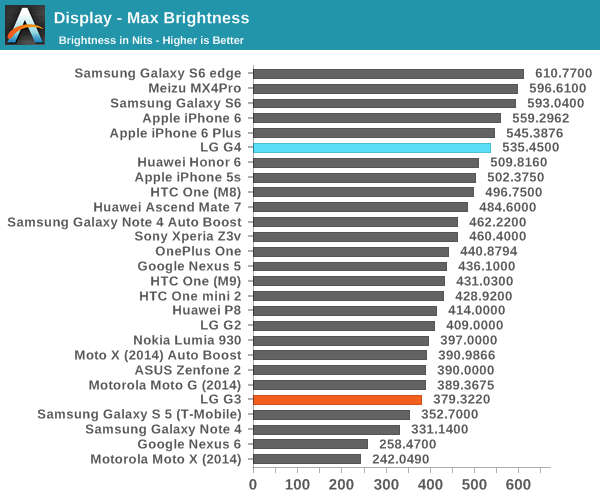

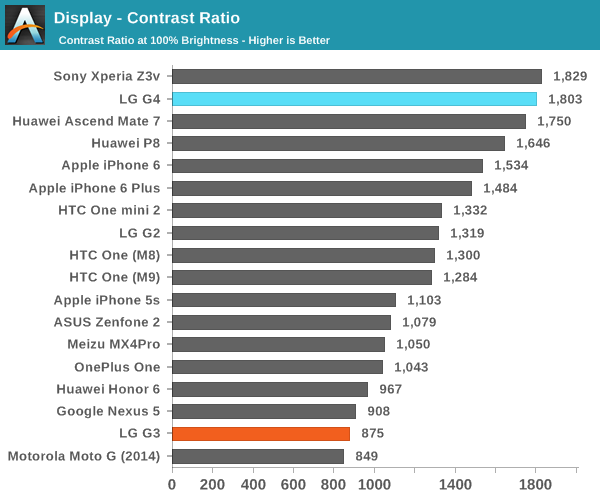
Our first test focuses on simple brightness and contrast at the highest brightness level. In this test, LG has managed to significantly improve their display over the G3, which puts the G4’s LCD at a somewhat average level for smartphones. It isn’t quite as high as the iPhone 6 or the Galaxy S6, but given the much higher subpixel density it’s an amazing showing and comparable to other smartphones that have stayed at 1080p.
Black levels are relatively low though, and the result is a surprisingly high contrast level for an LCD which remained around the same level even when using APL-constant patterns to defeat dynamic contrast at roughly 1500:1 static contrast. This was probably one of the first things that I noticed when using the LG G4, as the G3 in comparison was far more washed-out in just about every situation.
It seems that these improvements have been enabled with the use of photoalignment technology, which shares similarities with photolithography but attempts to induce anisotropy in a photoresist analogue on a glass substrate, which then influences the orientation of the deposited liquid crystals in the LCD. In daytime I didn’t have issues reading the display, although it isn’t as easy to read as the S6’s display with auto boost mode enabled.
While we’re still on the subject of contrast and color shifting, in my experience the LG G4’s display didn’t have any noticeable issues with wash-out unless you stare at a black image, and subjectively colors stay true to the eye in just about every viewing angle. The display is also laminated close to the glass, which makes the phone look like the display is painted on when you look closely at most images from extreme viewing angles. LG has also eliminated the rather annoying sharpening effects from the display, which counts as a pretty dramatic improvement in my book for readability as the sharpening effects on the G3 were incredibly annoying with extended reading.
sRGB
DCI
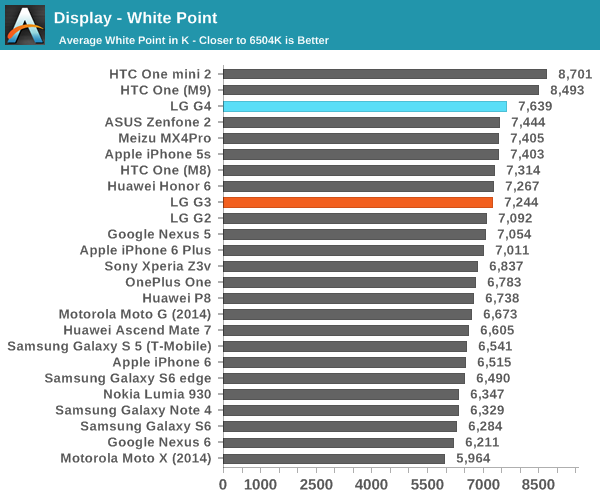
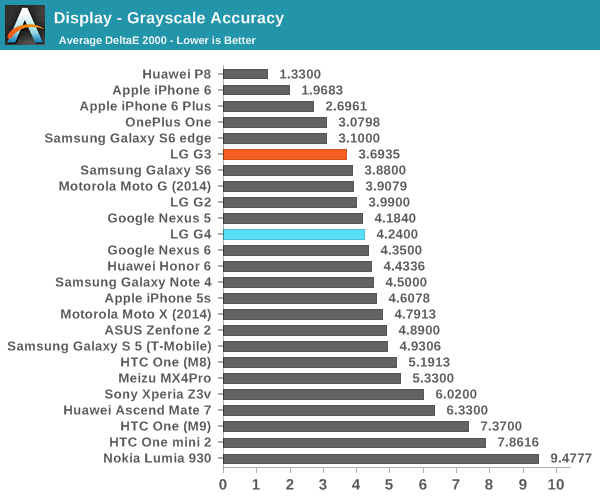
Moving on to the grayscale portion of the test, things get a bit less rosy. The G4’s display has a pretty strong blue cast to it much like the One M9, although gamma is relatively consistent if slightly low for presumably better shadow detail. I suspect this is partially done to improve peak brightness output and partially because a segment of end users prefer a cold display, but LG could improve their standing in this test by adding a toggle to set warm, neutral, and cold white points. As the DCI 1.2 gamut needs power 2.6 gamma and a relatively balanced white point, the G4 will have some problems with accurate rendition of grayscale with DCI content.
sRGB
DCI
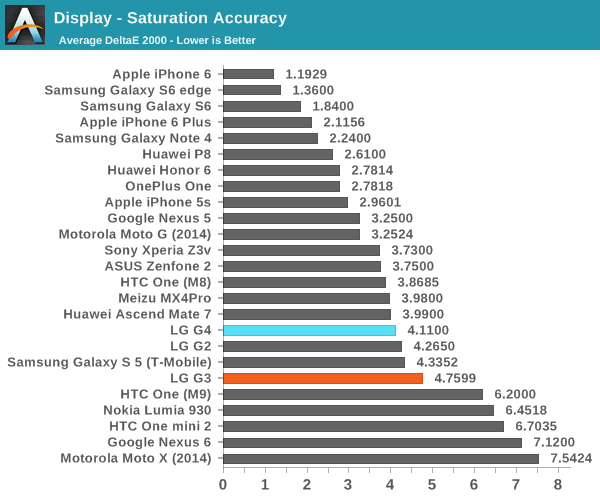
Looking at the saturation sweep for the display, we can immediately tell that the G4 misses the sRGB colorspace. However, the way this is done is rather uneven. On the red and magenta sweep, the color is correct up to 80% and it’s somewhere between 80 and 100% where the display will exceed sRGB. However, colors like cyan and green don’t do saturation compression, so the error from sRGB is evenly spaced. Blue ends up meeting sRGB pretty closely here despite saturation compression, which is an improvement from the significant saturation compression of the G3 display. Unfortunately, the excessively wide gamut results in a relatively average/poor showing in this test. Even when I target the DCI gamut, the issues with gamma and general calibration issues means that the average dE2000 error is roughly double that of the sRGB average dE2000 error at 8.89.
sRGB
DCI

As one might have guessed from the previous two results, the end result for the LG G4 is that color accuracy isn’t quite as good as one might have hoped. Due to an excessively wide gamut and a cold color cast, the G4’s display ends up slightly disappointing. Even when we target the DCI gamut for testing, the G4 falls short as the calibration is closer to the sRGB settings that we use than DCI with an average error of 9.72. However, the panel itself is high quality given the high contrast, relatively high peak luminance, and great viewing angles. As-is, it’s close to the Galaxy S6 and iPhone 6 Plus for display quality, but falls short due to lack of calibration. I think the solution here would be for LG to provide an sRGB toggle that would set white point to target 6504k and sRGB colorspace, but this would have to start with the LG G5 as it’s too late at this point to meaningfully change things here.


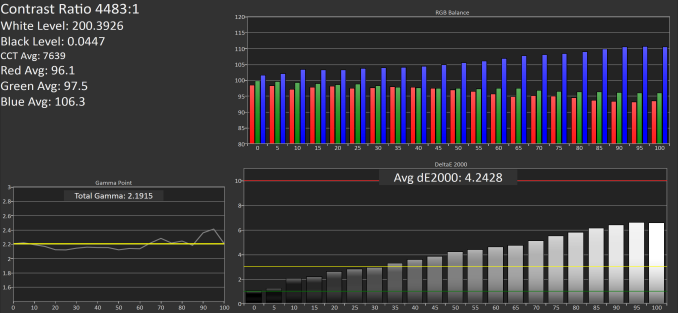
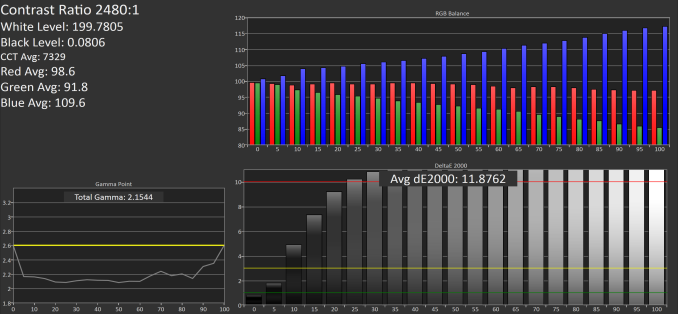
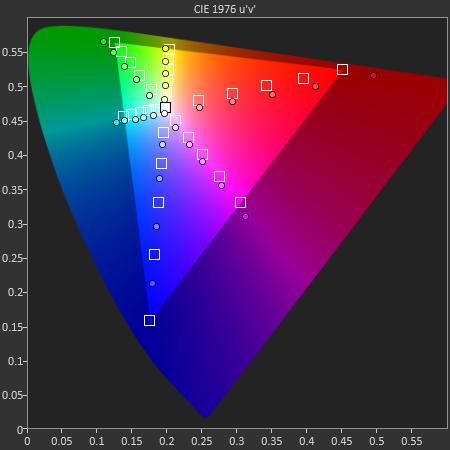


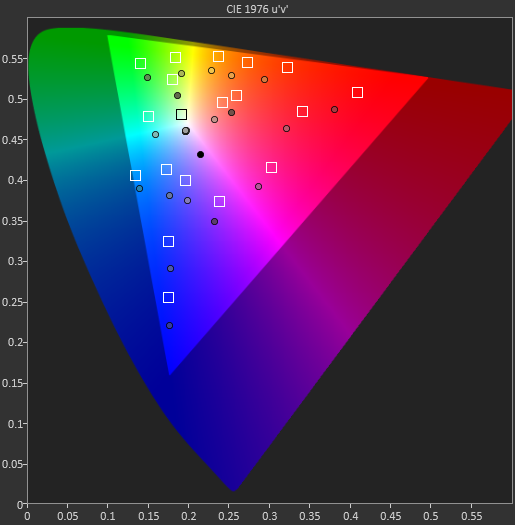








84 Comments
View All Comments
bleached - Sunday, August 2, 2015 - link
http://www.dxomark.com/Mobiles/Column-right/Mobile...Arcetnathon - Wednesday, August 5, 2015 - link
You point something really strange.Each review of tech website published month after release is worst than first tests.
Maybe big company doesn't play fair and send very specific smartphone that will never be in store...
akdj - Thursday, August 6, 2015 - link
As an owner of three of the top 5; S6, Note 4, & indeed... The iPhone 6+, which raps the 'top 5' "Apples is (sic) 'rate' in the top five'The 6+ is indeed produced by Apple ...my subjective feelings are almost identical to Josh's. S6 Edge is an incredible camera. I love it. My Note 4 always has been, with micro SD it makes shooting 4k practical, but my low light shots are pretty sad in comparison to the 6+, as well as 'action' or fast moving shots. S6 shoots 4k, excellent 1080p, but the video stabilization and 60fps-240fps adjustments on the iPhone tump the other two, and I'm just realizing I've placed my response after the wrong reply of your dxo link.
It's saying damn near what Josh concluded. DxoMark is specific to still photography, heavy on resolution and to those ends the sensors in the S6, N4 & G4 indeed play in the same field as the iPhone ...and in some cases beat it. That said, for simplicity point and shoot and nearly every time get an excellent shot without latency or buffering, the iPhone is hard to beat. Without G4 experience I'll hold judgement, but for video, the iPhone is it. For stills, I'm partial now to my S6 and the Note 4 has always been phenomenal
Apple opening their 'souls' a bit with the ability to interact with the SoC ala their native apps, there are plenty of manual control, high resolution shooters (using the 8 megapixel, 4K sensor and its speed) as well as slow motion and video editing tools --- probably the biggest weight in the iphone's favor is the App Store, it's amazing selection of editing and shooting tools as well as continuous updates might just top the subjective list of top 5.
*i don't own a 4K TV but I've got the ability to playback 4K on my MacBook Pro -- looks amazing but it's limited in length of time you can shoot and heats the camera up nice and warm. The S6, all around, my favorite for everything and now my go to camera in most situations. It's smaller and easier to shoot --- but for video capture, my son playing baseball, or last weeks Mötley Crüe show, the iPhone and it's incredible stabilization, video processing and iCloud uploading, ....see where I'm going?
I own a business, have for two decades and with a dozen employees equipped with their choice, I pay for them ...and have iPhone as a personal - S6 personal and Note4 business only. Primarily the stylus and autographs for credit cards has a cool vibe with clientele. You mileage may vary but dxo mark scores in the mid 80s rivals and defeats many point and shoot cams under $300. A point or two difference isn't real world, nor the bible on what to buy. Iphone is ranked 5 & 6 (+ & standard) - can't seem to find the Experia in America and their separation of a couple points in the mid 80as -- without considering motion at all, I'm not sure ANY is the wrong choice and for many that don't want manual control, the iPhone with HDR is hands down the layman's favorite. Android, I'm with the S6, double tap home button to pop the cam and it's rare even as a DSLR shooter that I'm adjusting settings, modes or manually selecting ISO, Aperture or shutter speed
S6 Edge, I love it. 6+, love it. Note 4, still awesome - bit heavier but easily used now with experience and the right case
Take motion into the equation and the limitations on 4K, post processing there of and playback ...I think this is the reason Apple has put this much effort into their sensor as it's the perfect 'size' for non cropped, full sensor 4K shooting
Maybe I'm confused, but I'm ambidextrous, love both and have owned both since 07/08. Dxomark is a silly geek site for resolution of serious optics. Those scores and their differential is hardly a 'win' for any flagship mentioned
J
Pissedoffyouth - Thursday, July 30, 2015 - link
How does the handoff between clusters cope compared to the 810? Does it scale from 2>4 cores when stepping down, averaging the load across the A53 cluster?nikaldro - Thursday, July 30, 2015 - link
The S808 throttles about as much as the exynos 7420.nikaldro - Thursday, July 30, 2015 - link
The S808 throttles about as much as the exynos 7420.grayson_carr - Thursday, July 30, 2015 - link
My God. I thought this review would never come. I already lusted after the G4, bought the G4, owned the G4 for a while, and then bought a Nexus 6 to replace it haha. Still, it will be good to know the Snapdragon 808 lowdown seeing as the Moto X 2015 and Nexus 5 2015 will make use of it.ThisIsChrisKim - Thursday, July 30, 2015 - link
I bought the G4 and I'm really liking it--camera is just superb. UI is meh, but not annoying enough for me to get something else.Nice seeing this review, nonetheless!
grayson_carr - Thursday, July 30, 2015 - link
I liked the G4 (maybe even more than the Galaxy S6 I owned before it), but there were a couple minor annoyances that ultimately led me to buy a Nexus 6. I found that the G4 performed well most of the time, but as mentioned in the review, in some apps it would drop frames more often than the previous two phones I owned (Nexus 5 and Galaxy S6). Also, the touchscreen seemed to be less responsive than the previous phones I owned, which started to get on my nerves. Finally, there were a couple software annoyances like the inability to expand notifications in some circumstances, that were bothering me. I did like the screen on the G4 better than the Galaxy S6 and Nexus 6, and the manual camera controls were boss, but ultimately I prefer the Nexus software experience.Fitnesspro - Thursday, July 30, 2015 - link
Grayson. You are right. Speed and battery count. I liked the G4 specs but was disappointed when tried the phone out at T Mobile. Has a snag and the actual screen id not